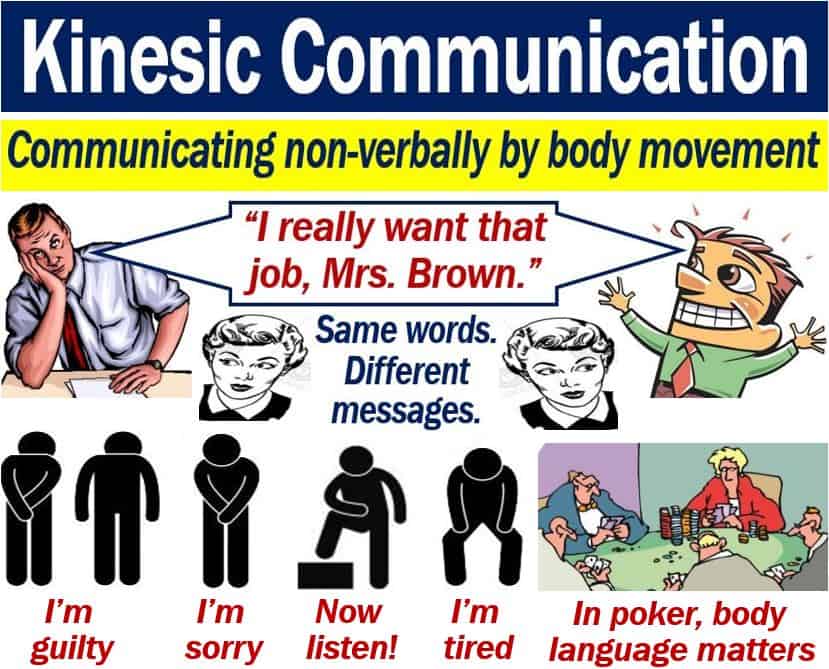Kinesic Communication is the technical term for body language, i.e., communicating by body movement. We call the study of kinesic communication Kinesics. Kinesic communication is a non-verbal form of communication. However, it is not the only non-verbal way of communicating with other people.
When we communicate with others, we can speak, i.e., utter words. We can use body movements such as gestures and facial expressions. We can also write letters, texts, and emails to other people.
People in one ship can communicate with those in another ship using Morse code or flags.
Kinesic communication is one of the many ways we can communicate non-verbally. Non-verbal communication is one of the processes of conveying messages without writing or uttering words.

Kinesic communication – body language
Kinesics or kinesic communication is all about communication through body movements, such as gestures and facial expressions. It is all about non-verbal behavior using any part of the body. It also includes communicating using the body as a whole.
In popular culture, we call this ‘body language’. In fact, the founder of kinesics, American anthropologist Ray Birdwhistell (1918-1994), never used the term ‘body language’.
He did not like the term, insisting that our bodies do not convey what linguists define as ‘language.’
Birdwhistell said kinesics meant:
“Facial expression, gestures, posture and gait, and visible arm and body movements.”
Birdwhistell filmed people in social situations and analyzed them. He showed how humans communicate in ways we had not clearly seen before.
He argued that all body movements convey meaning. In fact, he believed that non-verbal behavior had a grammar. A grammar that we could analyze in similar terms to spoken or written language.
Kinesic communication in interviews
Interviewers and police interrogators study kinesic communication. They say it helps them determine whether people they are interviewing are telling the truth.
Law enforcement officers say that suspects and witnesses involuntarily present telling indicators of deception through body language. They also present indicators of nervousness and receptiveness.
According to Birdwhistell, kinesics has become an integral part of police interrogations.
Police interrogators look for ‘confession behaviors,’ i.e., certain behaviors that indicate guilt.
Examples of confession behaviors include crying, talking using an explanatory tone of voice, or slumping on a chair.
In fact, even seemingly innocent actions such as pointing thumbs upward with clasped hands is a sign of lying in a statement.
Police interrogators and corporate interviewers use kinesic communication and verbal cues when talking to their interviewees.
Apart from helping them determine the veracity of what people are telling them, kinesics helps them glean other factors. For example, it helps them determine how keen or hesitant a job applicant is.
People who work in human resources are trained in many aspects of kinesics. Human resources is the department of a company or organization that hires, trains, and administers its workforce.
The ‘Not Face’
Did you know that there is a universal facial expression of negative emotion? We call it the ‘not face.’
This expression, a form of kinesic communication, is used and understood by everybody, say Researchers from Ohio State University and Purdue University, who carried out a study.

Study member, Aleix M. Martinez, from Ohio State University’s Department of Electrical and Computer Engineering, said:
“To our knowledge, this is the first evidence that the facial expressions we use to communicate negative moral judgment have been compounded into a unique, universal part of language.”
“Where did language come from? This is a question that the scientific community has grappled with for a very long time,” he continued. “This study strongly suggests a link between language and facial expressions of emotion.”
Related Vocabulary
The study of body language, or kinesics, encompasses a range of terms that describe various aspects of non-verbal communication. Below is a list of terms related to “kinesic,” their definitions, and examples of how they can be used in sentences:
-
Kinesic Analysis
The examination and interpretation of body movements as a form of non-verbal communication.
Example: “The detective conducted a kinesic analysis of the suspect’s behavior during the interrogation.”
-
Kinesic Cues
Non-verbal signals given through body movement or posture that can convey meaning or emotions.
Example: “During the presentation, his kinesic cues suggested that he was quite nervous.”
-
Kinesic Intelligence
The ability to read and interpret body language and non-verbal signals in communication.
Example: “Her kinesic intelligence allowed her to notice that the jury was not convinced by the witness’s testimony.”
-
Kinesic Slip
An inadvertent movement or gesture that may reveal a person’s true feelings, similar to a Freudian slip but in body language.
Example: “His quick glance to the door was a kinesic slip that betrayed his desire to leave the meeting.”
-
Kinesic Synchrony
The phenomenon where individuals in interaction unconsciously mimic each other’s body movements.
Example: “The couple’s kinesic synchrony was evident as they both leaned in simultaneously to look at the photo.”
-
Kinesic Communication
The conveyance of messages or emotions through gestures, facial expressions, and postures.
Example: “Kinesic communication is essential in dance, where movement expresses the art’s narrative.”
-
Kinesic Empathy
The capacity to understand and share the feelings of another person through their body language.
Example: “As a therapist, she developed a strong kinesic empathy that helped her connect with clients.”
